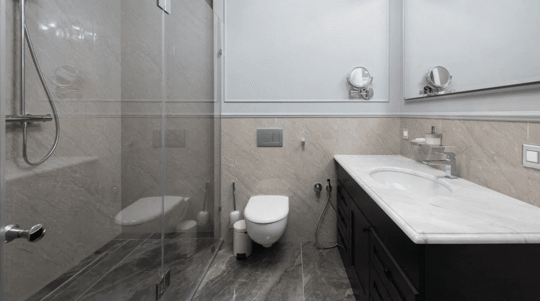Flushing the toilet two to three times after going to the bathroom can be so frustrating. Using thinner toilet paper, plungers, and adding extra water to your toilet bowl manually is tiring. If you are tired of all these grueling tasks, it may be time for you to change to a power flush toilet.
However, there are two main kinds of toilets: gravity-flow and pressure-assist or power flush. The most popular is the gravity-flow toilet, a primary type of toilet that has water inside the toilet tank. A power or pressure-assist toilet is different from a gravity-flow toilet in one department – the inside of the toilet tank.
Pressure-assist or power flush toilets uses less water yet flush with more force than a standard gravity-powered toilet. Meaning no more flushing of that toilet multiple times, thus cutting down the water bill.
Power Flush Toilet Design and Features
A power flush is designed in such a way that waste is removed effectively from the bowl and leave it clean for the next user. Power flush toilets are just like standard gravity-fed toilets but instead of a pool of water, you will see a sealed, plastic pressure tank that contains water and air.
Features of a Power Flush
- Clears the bowl with just a push.
- The second flush is not required thus uses less water.
- Keeps bowl clean due to its “Scrubbing action.”
- Because the water is held in a plastic tank, it does not sweat.
- The main benefit is clogs and blockages are virtually eliminated.
The Difference in Flush Capability
A standard toilet utilizes 1.6 gallons of water that are held in the tank. The same applies to standard and gravity toilets. If you remove the cover of the tank of your toilet, you would see a flapper. This falls flat over a hole in the bottom of the tank to hold the water in the tank. If you flush the toilet, this flapper raises, and the water flows down the hole, into the toilet bowl, and produces a swirl of water that drives the waste down through to the trap.
One flush in a gravity (standard) toilet will drive the waste out into the sewer about 30 feet. Power flush or pressure-assisted toilets have no visible water in the tank.
If you remove the cover from the tank of a power flush toilet, you will see a smaller tank that has a pressure vessel. The pressure vessel holds air, and as it partially fills with water, it utilizes the water supply line pressure to compress the trapped air inside.
The compressed air is what pushes the water into the bowl. All this is activated when you flush the toilet. This pushes the water out at a much higher rate with more power and takes the waste out via the sewer over 60 feet.
Life of a Power Flush Toilet
These toilets are designed to work more efficiently and last longer. With fewer flushes, you have little wear and tear on the working parts of the toilet. These toilets create natural scrubbing action to keep the bowl clean and result in less “toilet brush” cleaning, which will eat away at the enamel. In other words, power flush toilets are designed to last.
Cons of a Power Flush Toilet
- Noise. Power flush toilets are famous within industrial settings because they are far more efficient than gravity-flow toilets. But most homeowners do not buy power flush toilets since these toilets tend to be rather loud.
- Availability of parts. The inner workings of a power flush toilet are not the same as a gravity-flow toilet. Since most hardware stores don’t stock these parts continuously, repairing or replacing parts components of a pressurized toilet is somewhat hard.
- Price. Power flush toilets are more expensive than regular gravity-flow toilets. While a standard gravity-flow toilet can be bought for around $120 to $300, a power flush toilet may cost as much as $700.
- The difficulty of flushing. The flush lever on a power flush toilet must be pushed with more force than on gravity-flow fixture. This may make it hard for a little kid or a strength-impaired adult to operate.
Pros of a Power Flush Toilet
- Efficiency. Power flush toilets are much more efficient, all thanks to their forceful flush. You don’t need any reason to flush twice, and toilet clogs are rare, even in aging plumbing pipes.
- Water savings. Power flush toilets help to save water. Each flush of a power flush toilet uses 1.1 to 1.2 gallons. But a dual flush gravity-flow uses 1.3 gallons or single flow (1.6). This alone can sum up to about 4,000 gallons in a year.
- Lower maintenance. A power flush toilet contains less moving parts, meaning it may likely break down and need servicing. Compared to a gravity-flow toilet that can easily break up.
- No condensation. Lastly, a lot of business owners and homeowners choose power flush toilets because these toilets are not affected by humid weather. That is because the tank-in-tank design reduces any amount of sweat.
If you compare the pros and cons of a power flush toilet to that of a gravity-flow toilet, you will know the right kind of toilet for your home.
Conclusion
Spending a little more for a proper toilet far outweighs itself if you have kids in your family. The power flush toilet provides better hygiene because you are flushing the waste away. This toilet will also save you a lot of money by cutting down on your monthly water bill.
In need of a plumber in Connecticut – Book an Appointment with A-Team Plumbing today!

